Stefan C. Kremer
Towards Stable Preferences for Stakeholder-aligned Machine Learning
Feb 02, 2024

Abstract:In response to the pressing challenge of kidney allocation, characterized by growing demands for organs, this research sets out to develop a data-driven solution to this problem, which also incorporates stakeholder values. The primary objective of this study is to create a method for learning both individual and group-level preferences pertaining to kidney allocations. Drawing upon data from the 'Pairwise Kidney Patient Online Survey.' Leveraging two distinct datasets and evaluating across three levels - Individual, Group and Stability - we employ machine learning classifiers assessed through several metrics. The Individual level model predicts individual participant preferences, the Group level model aggregates preferences across participants, and the Stability level model, an extension of the Group level, evaluates the stability of these preferences over time. By incorporating stakeholder preferences into the kidney allocation process, we aspire to advance the ethical dimensions of organ transplantation, contributing to more transparent and equitable practices while promoting the integration of moral values into algorithmic decision-making.
Similarity Learning Networks for Animal Individual Re-Identification - Beyond the Capabilities of a Human Observer
Feb 21, 2019

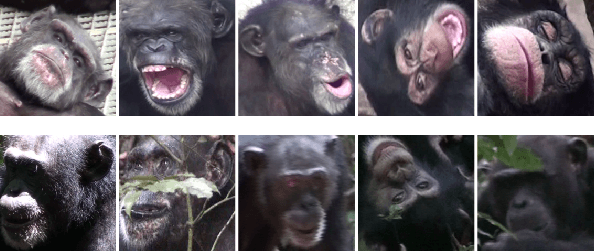
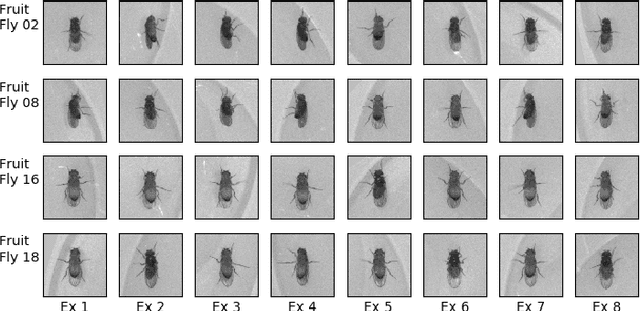
Abstract:The ability of a researcher to re-identify (re-ID) an animal individual upon re-encounter is fundamental for addressing a broad range of questions in the study of ecosystem function, community and population dynamics, and behavioural ecology. Tagging animals during mark and recapture studies is the most common method for reliable animal re-ID however camera traps are a desirable alternative, requiring less labour, much less intrusion, and prolonged and continuous monitoring into an environment. Despite these advantages, the analyses of camera traps and video for re-ID by humans are criticized for their biases related to human judgment and inconsistencies between analyses. Recent years have witnessed the emergence of deep learning systems which re-ID humans based on image and video data with near perfect accuracy. Despite this success, there are limited examples of this approach for animal re-ID. Here, we demonstrate the viability of novel deep similarity learning methods on five species: humans, chimpanzees, humpback whales, octopus and fruit flies. Our implementation demonstrates the generality of this framework as the same process provides accurate results beyond the capabilities of a human observer. In combination with a species object detection model, this methodology will allow ecologists with camera/video trap data to re-identify individuals that exit and re-enter the camera frame. Our expectation is that this is just the beginning of a major trend that could stand to revolutionize the analysis of camera trap data and, ultimately, our approach to animal ecology.
Past, Present, and Future Approaches Using Computer Vision for Animal Re-Identification from Camera Trap Data
Nov 19, 2018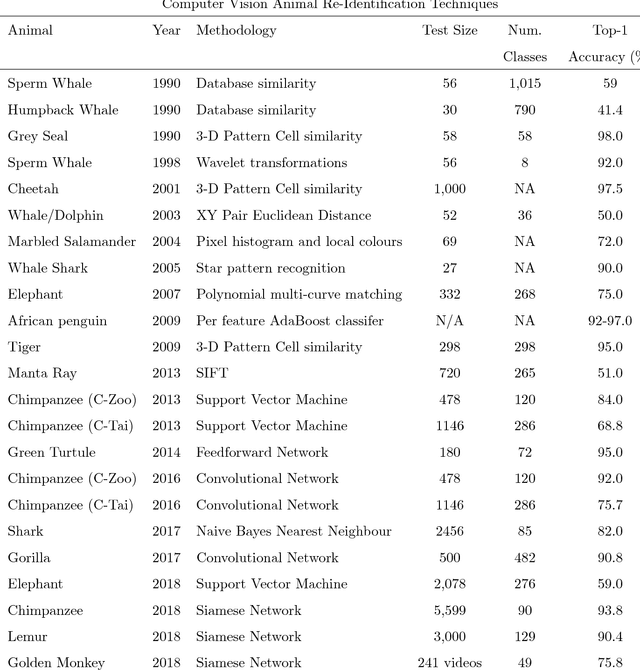
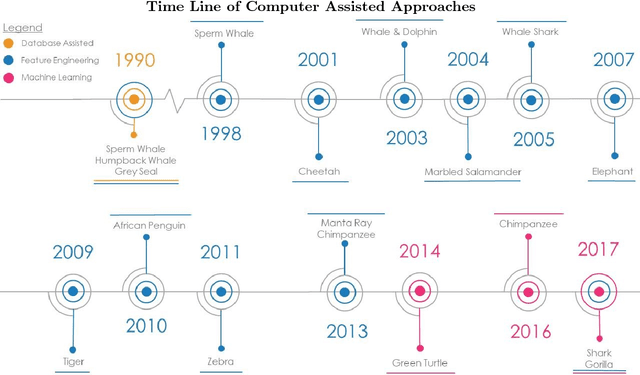
Abstract:The ability of a researcher to re-identify (re-ID) an individual animal upon re-encounter is fundamental for addressing a broad range of questions in the study of ecosystem function, community and population dynamics, and behavioural ecology. In this review, we describe a brief history of camera traps for re-ID, present a collection of computer vision feature engineering methodologies previously used for animal re-ID, provide an introduction to the underlying mechanisms of deep learning relevant to animal re-ID, highlight the success of deep learning methods for human re-ID, describe the few ecological studies currently utilizing deep learning for camera trap analyses, and our predictions for near future methodologies based on the rapid development of deep learning methods. By utilizing novel deep learning methods for object detection and similarity comparisons, ecologists can extract animals from an image/video data and train deep learning classifiers to re-ID animal individuals beyond the capabilities of a human observer. This methodology will allow ecologists with camera/video trap data to re-identify individuals that exit and re-enter the camera frame. Our expectation is that this is just the beginning of a major trend that could stand to revolutionize the analysis of camera trap data and, ultimately, our approach to animal ecology.
Deep Learning Object Detection Methods for Ecological Camera Trap Data
Mar 28, 2018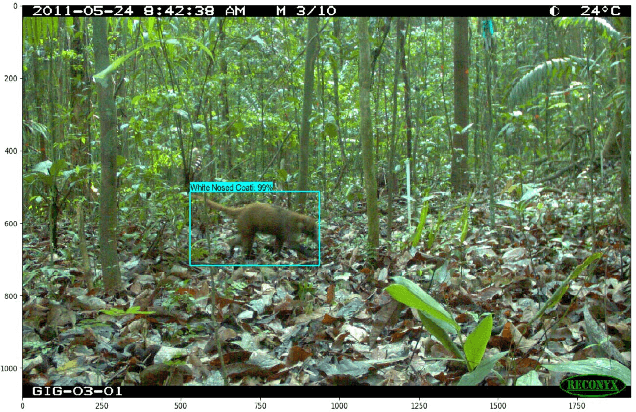
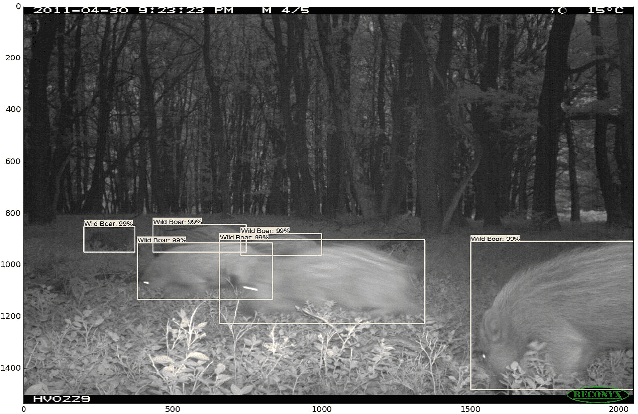
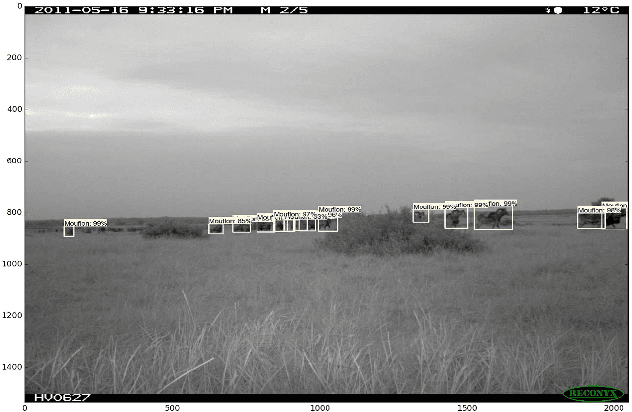
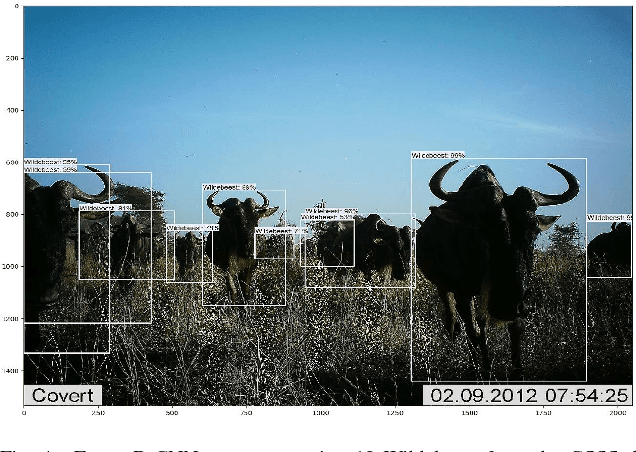
Abstract:Deep learning methods for computer vision tasks show promise for automating the data analysis of camera trap images. Ecological camera traps are a common approach for monitoring an ecosystem's animal population, as they provide continual insight into an environment without being intrusive. However, the analysis of camera trap images is expensive, labour intensive, and time consuming. Recent advances in the field of deep learning for object detection show promise towards automating the analysis of camera trap images. Here, we demonstrate their capabilities by training and comparing two deep learning object detection classifiers, Faster R-CNN and YOLO v2.0, to identify, quantify, and localize animal species within camera trap images using the Reconyx Camera Trap and the self-labeled Gold Standard Snapshot Serengeti data sets. When trained on large labeled datasets, object recognition methods have shown success. We demonstrate their use, in the context of realistically sized ecological data sets, by testing if object detection methods are applicable for ecological research scenarios when utilizing transfer learning. Faster R-CNN outperformed YOLO v2.0 with average accuracies of 93.0\% and 76.7\% on the two data sets, respectively. Our findings show promising steps towards the automation of the labourious task of labeling camera trap images, which can be used to improve our understanding of the population dynamics of ecosystems across the planet.
 Add to Chrome
Add to Chrome Add to Firefox
Add to Firefox Add to Edge
Add to Edge